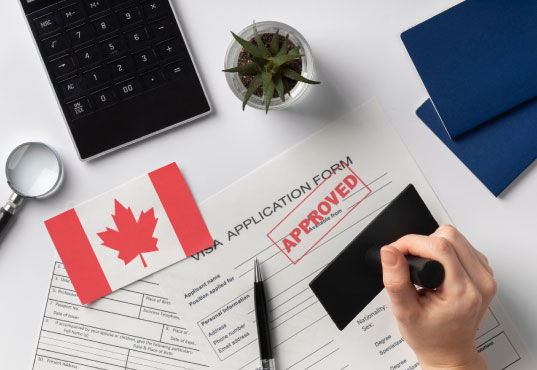How To Apply for A Student Visa to Canada?
Canada is famous for its rich cultural heritage and elite universities, which attract students from all around the world to get the benefits of higher education in the land of opportunities like Canada.
That’s why getting a student visa to Canada is a necessary step to complete before entering Canadian soil. Although navigating the student visa to Canada application procedure may be difficult, do not worry! This comprehensive guide will help you through each step of admission to your desired Canadian university. We will explain the entire process, from the different types of visas available to the needed and qualifications paperwork; we will also demystify how to apply, how long the process should take, and where to apply for a student visa to Canada.

This article provides all the necessary information on whether you want to study, law, engineering, business, medical, or the arts. Moreover, we also explore your options for examining the various programs for financing your education you can enroll in as an international student. So, buckle up as we set out to discuss the mysteries of the student visa to Canada application procedure.
Type Of Student Visa to Canada
Different visas are available for one willing to visit Canada from India. The study permit is a major visa for international students. Students may also need a temporary resident visa to enter Canada based on their nationality. The following mentioned ways are part of primary visa categories:
Visitor Visa (Temporary Resident Visa):
To enter Canada, citizens of nations not exempt from visa requirements must get a Temporary Resident Visa (TRV). Travel, visiting relatives, and business travel are all permitted in Canada with this visa. A visitor visa is usually granted for a maximum of six months.
International students who want to continue their education in Canada must get a study permit. A Designated Learning Institution (DLI) has given this authorization, which enables students to pursue professional, vocational, or academic training. The study permit is typically good for the duration of the program, plus an extra period if necessary to finish courses or graduate.
To work temporarily in Canada, people must have a work permit. There are several varieties of work permits, such as post-graduation, employer-specific, and open work permits. Usually, employment offers are linked to work permits, or they need company sponsorship.
A Permanent Residence (PR) Visa:
Enables foreign nationals to reside permanently in Canada and enjoy the majority of the rights and privileges accorded to Canadian citizens. Provincial Nominee Programmes (PNPs), family sponsorship, the Express Entry system, and refugee status are all avenues to permanent residence.
Working Holiday Visa:
Thanks to Canada’s agreements with some nations, young people can participate in the Working Holiday program. With this visa, people can work and travel in Canada for a predetermined amount of time, usually up to a year, giving them the opportunity to see the nation and gain job experience.
People visiting Canada for business purposes, such as attending meetings, conferences, or negotiations, are eligible to apply for a business visa. These visas may have specific requirements and are typically only issued for certain periods.
It’s crucial to remember that every type of visa has unique prerequisites, qualifications, and application processes. Consult a Canadian embassy or consulate in your nation like Fly High Abroad to help you in applying for a Student visa to Canada, or visit the official Immigration, Refugees, and Citizenship Canada (IRCC) website for the most up-to-date and accurate information on visa kinds and requirements.

Student Visa to Canada Eligibility
To be eligible for a student visa to Canada, you must demonstrate the following:
- A valid letter of acceptance.
- Proof of financial stability to cover your living expenses and academic fees.
- Clear criminal record and good health.
- Plan to leave Canada after completing your studies.
- You are fulfilling all additional requirements necessary to your country of residence.
Documents Required for A Student Visa to Canada
When applying for a student visa to Canada, you just need to gather the following documents, including:
- A valid passport
- Letter of acceptance from DLI.
- Proof of financial support.
- Complete application forms.
- Certificates and educational transcripts
- French and English language proficiency test results.
- Letter of intent or statement of purpose.
- Medical examination results if required.
Student Visa to Canada Process
Getting a student visa to Canada entails a few crucial processes. Here is a complete guide to help you in navigating:
Step 1: Acceptance by a Designated Learning Institution (DLI)
First, get accepted into a (DLI) in Canada. A DLI is a school that has been granted permission by the Canadian government to accept international students. You can continue the visa application process once you receive an acceptance letter from a DLI.
Step 2: Compile the Necessary Records
Gather all the required documents to apply student visa to Canada. This usually includes a valid passport, your DLI admission letter, filled-out application forms, evidence of financial support, academic transcripts, language proficiency test results, a statement of purpose, and any other paperwork requested by the Canadian government.
Step 3: Create an Internet Account
Create an online account on Immigration, Refugees, and Citizenship Canada’s official website (IRCC). With this account, you can track the progress of your application, submit it, and pay the required fees.
Step 4: Application Fee Payment
You must pay an application cost depending on the kind of visa you need and where you live. You can make this payment online on the IRCC website using a legitimate payment method.
Step 5: Finish the application and send it in
Complete the visa application as thoroughly and precisely as possible. Please fill out all the requested fields with your name, contact information, educational background, and chosen course of study. Upload the necessary files and submit your application using your online account.
Step 6: Enrolment in biometrics (if appropriate)
You may be required to submit biometrics (a picture and your fingerprints) as part of the visa application procedure, depending on your country of origin. When applying for a visa, you will be given directions on where and how to take your fingerprints, typically at a specific location,
Step 7: Go to the interview (if necessary)
You may occasionally be asked to appear for an interview at the Canadian consulate or embassy in your nation. This interview aids in determining your eligibility and confirming the data in your application. If required, you will be communicated details about the interview.
Step 8: Await the Decision on Your Visa
Your application starts processing as soon as it is submitted. After evaluating it and performing the required investigations, the Canadian government will decide whether to issue you a visa. It’s crucial to verify the most recent processing timelines on the IRCC website, as they can differ.
Step 9: Get your visa and passport
Once a decision is reached, you will receive your passport through the mail or a particular visa application center with the visa stamped inside. Ensure you return your passport with your working address and contact details.
By carefully following these instructions, you may guarantee a seamless application procedure for your Canadian student visa. Always check the official IRCC website or contact the closest Canadian embassy or consulate for the most recent and accurate information.
Where Can You Apply for A Student Visa in Canada?
The application for a student visa to Canada is submitted online through the official website of Immigration, refugees, and Citizenship Canada (IRCC). It is necessary to create an online account and follow all the instructions provided. Here are the easy steps to apply:
Visit the IRRC official website:
Create an account: after visiting the IRCC website, create an account. This account will be used to access and submit your visa application online.
Fill Out the Online Application Form:
Fill out the online form correctly and provide all the necessary information.
Now Upload Supporting Documents:
As we discussed, the applicant must gather all the required documents. Scan your metric, intermediate, and all other educational documents and upload them to your online application.
Pay The Required Application Fee:
Now, using valid payment options, pay the required Student visa to Canada application fees. The IRRC website is where you may pay the cost.
Apply:
Once you carefully complete the application form and upload all the required documents, review your application to ensure accuracy.
Track your application progress:
After submitting your application online, you can track your application progress using your IRCC online account. This will allow the candidate to stay up to date on the status of their student visa to Canada application.
Final Verdict
Pursuing higher education in Canada is a rewarding experience, but sometimes, it requires an additional financial commitment. However, there are essential ways to pay for your education, including grants, part-time jobs, student loans, bursaries, and scholarships. Finding the best funding options is important if you are an overseas student. Fortunately, many solutions are accessible, Fly High Abroad being one of them.
Fly High Abroad is a well-known platform that provides online consultancy services, especially for international students attending foreign universities. They help you choose the right visa as per your requirements and guide you through each step of filling out the application form and submitting it until you get your student visa to Canada.


